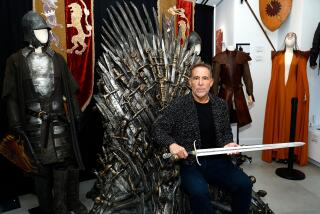London Museum Gets S. Pole Relics
- Share via
LONDON — The National Maritime Museum won three coveted relics of one of Britain’s most famous polar expeditions during a fierce bidding war Friday at Christie’s auction house.
The museum paid $81,100 for Capt. Robert Scott’s watch and sledging satchel and the snow goggles used on his fatal 1912 trek to the South Pole.
The museum, concerned that the historic items would be sold abroad, teamed up with the Antarctic Heritage Trust during the auction. Together, they managed to buy parts from Scott’s stove for $43,000, along with eight linen ration bags for $17,700. The items were found beside Scott’s body in the tent where he and two others froze to death two months after reaching the South Pole. His was the second team to reach the pole.
On Thursday, Christie’s had bowed to pressure and withdrawn two items from the auction for private sale.
The National Maritime Museum then purchased the silk sled flag flown by Scott at the South Pole and a liquid boat compass used by Scott’s contemporary, Sir Ernest Shackleton, to navigate a lifeboat from his icebound ship Endurance in 1915-16.
“Ten days ago, it looked like we would lose everything, so at least we could save some items for this country,” said David Wilson, 35, a lecturer in Antarctic history whose great-uncle died along with Scott in the 1912 expedition.
Wilson, the museum and the trust have been leading a public fight since last week, when Christie’s announced that it would sell more than 50 mementos belonging to Scott and Shackleton on behalf of the explorers’ relatives.
The team had hoped to buy Shackleton’s Royal Standard but lost the flag to an anonymous phone bidder for $90,860.
The Royal Standard was presented to Shackleton by Alexandra, the mother of King George V, in 1914 on board the Endurance, and if the flag is to be taken out of Britain by its new owner, the museum plans to put up a fight.
“If it did go to an overseas buyer, then we will seek to put a stop on it through the export license,” said David Spence, director of displays for the Maritime Museum.
Shackleton and Scott failed in their separate quests to be the first to the South Pole, but their daring exploits made them national heroes.
Bidding was heated during the two-hour auction, and many items went for three and four times their estimated value.
The remains of a biscuit found next to Scott’s frozen body in 1912 went to a mystery bidder for $6,327, and a portrait of Shackleton was sold to an anonymous phone bidder for more than $81,800, double its estimate. Scott’s goggles sold for $48,100, six times Christie’s estimate.
More to Read
Sign up for Essential California
The most important California stories and recommendations in your inbox every morning.
You may occasionally receive promotional content from the Los Angeles Times.













